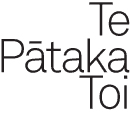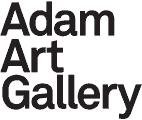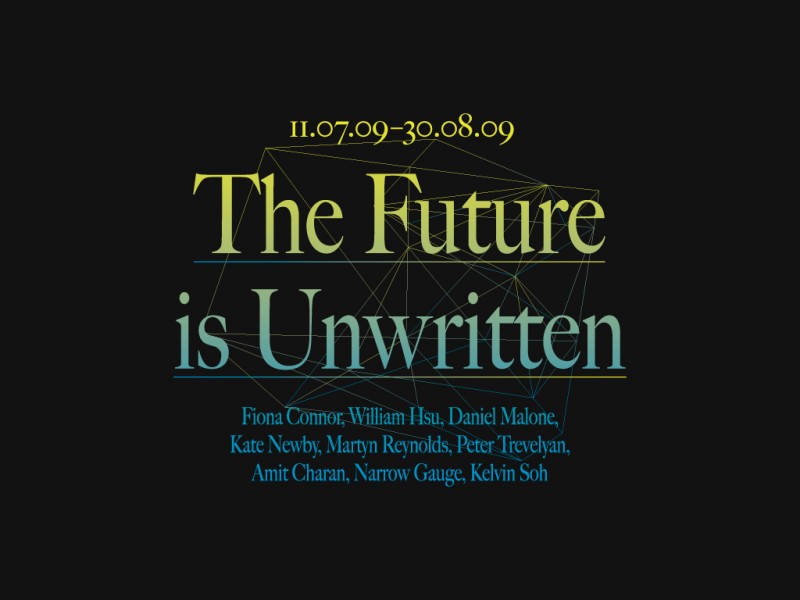The Future is Unwritten
11 July - 30 August 2009
Onsite: Fiona Connor, William Hsu, Daniel Malone, Kate Newby, Martyn Reynolds, Peter Trevelyan
Online: Amit Charan, Narrow Gauge, Kelvin Soh
Curated by Laura Preston
The starting point for this exhibition project was an invitation to nine artists, designers, and writers to consider how art can engage, by means of its aesthetic forms and structures, in the political realities of this moment. The project became a series of exhibition proposals for embracing uncertainty, where structures and systems that we have come to know are being brought into focus and re-defined. Using the university gallery as a site for proposition and interdisciplinary thinking as much as a place for display, the work presented both in the building and online questioned the political efficacy of contemporary art today and suggested other ways for art to claim space and being resourceful within it.
Online publication
www.adamartgallery.org.nz/thefuture
Fiona Connor’s Project 2009–
alettertotheunwrittenfuture.org
Curator Laura Preston’s introduction:
I’d like to propose that the exhibition is a beginning rather than the culmination of the event. I wanted to address the difficult, perhaps even irresolvable question, of art’s political efficacy by using the gallery as a place of proposition. Given its location at the university – a site of ‘higher’ learning and an ideal model where disciplines co-exist – and the idiosyncratic character of the building’s architecture, I thought it a useful site to consider the shape of power, and the appeal to ‘un-write’ and model alternatives to the institutions we know.
We are currently facing a time of transition and awakening to the insidious power of capitalism that it has affected so many arenas of our lived experience for better or for worse. As much as the individual reigns, there is seemingly an increased desire for social renewal; evident in the proliferation of online social network infrastructures and the rallying efforts in sharing concern for and awareness of the environment – similarly informed and supported by an industry dedicated to developing and marketing technologies. Whether personally determined or media coerced (which maybe one and same), generally speaking there is a condition of looking toward energy consumption and its conserve. This extends to other aspects of lived experience within this just-in-time milieu, from how we perform our daily roles and the expectation to deliver in outcome-oriented ways. It is a time to take stock and to recognise just how far we have come (which may be to say, how much we have lost as much as gained).
In acknowledging that we are experiencing a time of crisis there is simultaneously an interest in understanding the course of change. A pertinent example of this, considering that this is the year of the 20th anniversary since the fall of the Berlin Wall, is the question of how the wall eventually fell. The actual act came about all rather unexpectedly. Although the long-awaited unification was in preparation and much consultation had been in play behind the scenes, the final decision came in a public slipup, a mistaken command that released the border too soon, presented before the world’s media to verify. Neo-liberalism swept in.
Too often history proves that revolution and its abrupt overhaul only ends up with a shifting back to the same old model of power. How then does any re-writing of the status quo occur and avoid being co-opted, marketed back to us, and used by the powerful? If the collective was to rally against the system once more, how might a sense of politicised collectivity and, in effect, a new form of institution be shaped presently? Would it be, is it all the more possible, considering the hyperlinked, immaterial environment we have come to communicate within?
Coming back to the building: It is in keeping with this climate of transition that the architectural framework of the Adam Art Gallery is engaged by this project. The building follows the structure of a pre-existing stairway; a site that invites perambulation and an expectation that you arrive somewhere else to where you began. What is beyond expectations is the history of the building. It was built between two others acting like an intervention, a jump cut between two known frames of reference; like making visible the operations of narrative when placing two images side by side.
Inviting a response to the institution of the gallery within the institution of the university provides a double framework to contend with. The evidential weight of the university gallery as a site for research and critical thinking, and as a forum for the re-visioning of art histories invites critique of this construction – the artist draws an alternative, an escape plan beyond the borders of art’s inherited politics and hegemony yet simultaneously embraces the possibilities this knowledge economy offers.
The artists I have invited to work with me on this project were selected for their sculptural intent on framing the performativity latent within a site. Not always working with the ‘material’ of the gallery and not necessarily interested in undertaking a mannered exposé of the institution, each of the nine artists and designers utilise a context responsive approach. They have inherited the critical tradition of conceptualism that treats art as a mode of thought, and they are conversant in presenting process as part of their work. These practitioners do not have conventional studio practices; rather the way they work is indicative of the increasingly common practice of responding to the curatorial call of the institution, and for their work to be generated out of conversation and collaboration. Further still, what links each of them is their interest in moving beyond, or perhaps it is better to say, sidelining, the ironic impasse of postmodernism and its insular re-enactment of art history, to re-assert the possibilities for art to tap the tenor of experience that includes knowing without knowing [1]. Sharing this commonality is political.
Philosopher Jacques Rancière positions the political in art as not residing in the effectiveness of transmitting messages, but in believing in the power of form itself [2]. The formal arrangements, tangible and intangible, that art produces provide an abstract language that cannot necessarily be written nor decoded. Ranciere offers a means to consider the embrace of art’s broader intellectualism, placing value once again on what is felt and to re-engage with art’s affect. Marxist philosopher and semiologist, Paolo Virno also asserts that form can build new structures of thinking [3]. Although pretentious to believe that art can aspire to utopian models (or even anarchic) and produce new systems to live by, it does seems timely to underscore that art is reflexive and a matter of feeling. With these ideas in mind, I propose that the gallery is the site of rehearsal for these actions, but one not predicated on anticipation and working towards resolution.
Thinking back to the Wall and considering that significant change may just happen one day as though by surprise yet based on incremental developments and small acts, this exhibition proposes that art is writing the future but in ways that keeps it unwritten. In the interest of forming an exhibition that is resourceful and which may in fact become a resource for future activity, what you may find at the gallery and what you may see online are forms and structures unfolding.
Laura Preston, 2009
[1] W. G. Sebald’s fiction through words and images elucidates on the ways in which we know without knowing, and remember without memory.
[2] Jacques Rancière, The Politics of Aesthetics: The Distribution of the Sensible. London: Continuum, 2006
[3] Paolo Virno interview in Open 17:A Precarious Existence Vulnerability. Rotterdam: Nai Publishers, 2009
Photography: Michael Salmon.
Click here to view the public programme events associated with this exhibition.















